
Castlefield is an inner-city conservation area in Manchester, North West England. The conservation area which bears its name is bounded by the River Irwell, Quay Street, Deansgate and Chester Road. It was the site of the Roman era fort of Mamucium or Mancunium which gave its name to Manchester. It was the terminus of the Bridgewater Canal, the world's first industrial canal, built in 1764; the oldest canal warehouse opened in 1779. The world's first passenger railway terminated here in 1830, at Liverpool Road railway station and the first railway warehouse opened here in 1831.

Built in 1716–17 as a charity school, Bluecoat Chambers in School Lane is the oldest surviving building in central Liverpool, England. Following the Liverpool Blue Coat School's move to another site in 1906, the building was rented from 1907 onwards by the Sandon Studios Society. Based on the presence of this art society and the subsequent formation of the Bluecoat Society of Arts in 1927, the successor organisation laid claim to being the oldest arts centre in Great Britain, now called the Bluecoat.

The Greek Orthodox Church of St Nicholas is a Grade II Listed building in Toxteth, Liverpool, situated at the junction of Berkley Street and Princes Road. Built in the Neo-Byzantine architecture style, it was completed in 1870. The architects were W. & J. Hay and the church was built by Henry Sumners. It is an enlarged version of St Theodore's church in Constantinople.
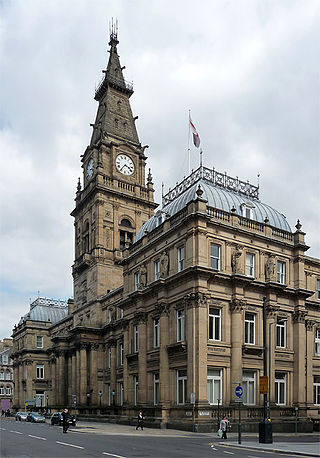
Municipal Buildings is a former council office building that has been converted into a hotel. It is located on Dale Street in the centre of Liverpool, England. It is a Grade II* listed building.

Birmingham Curzon Street railway station was a railway station in central Birmingham, England. Initially used as a major early passenger terminus before being eclipsed by newer facilities and converted into a goods depot, it was a continuously active railway facility up until 1966.

Fowler’s Buildings is an office building and warehouse located at 3–9 Victoria Street and 1–3 Temple Lane. Liverpool, England. They were constructed in two phases between 1865 and 1869, for the Fowler brothers, who were produce dealers, and were designed by the local architect J. A. Picton. The whole structure is recorded in the National Heritage List for England as a designated Grade II* listed building.

Manchester Central railway station was a railway station in Manchester city centre, England. One of Manchester's main railway terminals between 1880 and 1969, the building was converted into an exhibition and conference centre which was opened in 1986, originally known as G-MEX, but now named Manchester Central. The structure is a Grade II* listed building.
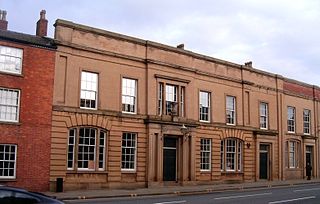
Liverpool Road is a former railway station on the Liverpool and Manchester Railway in Manchester, England; it opened on 15 September 1830. The station was the Manchester terminus of the world's first inter-city passenger railway in which all services were hauled by timetabled steam locomotives. It is the world's oldest surviving terminal railway station. With tracks running at a first floor level behind the building, it could also be considered one of the world's first elevated railway stations.

The architecture of Manchester demonstrates a rich variety of architectural styles. The city is a product of the Industrial Revolution and is known as the first modern, industrial city. Manchester is noted for its warehouses, railway viaducts, cotton mills and canals – remnants of its past when the city produced and traded goods. Manchester has minimal Georgian or medieval architecture to speak of and consequently has a vast array of 19th and early 20th-century architecture styles; examples include Palazzo, Neo-Gothic, Venetian Gothic, Edwardian baroque, Art Nouveau, Art Deco and the Neo-Classical.

The architecture of Liverpool is rooted in the city's development into a major port of the British Empire. It encompasses a variety of architectural styles of the past 300 years, while next to nothing remains of its medieval structures which would have dated back as far as the 13th century. Erected 1716–18, Bluecoat Chambers is supposed to be the oldest surviving building in central Liverpool.

Liverpool is a city and port in Merseyside, England, which contains many listed buildings. A listed building is a structure designated by English Heritage of being of architectural and/or of historical importance and, as such, is included in the National Heritage List for England. There are three grades of listing, according to the degree of importance of the structure. Grade I includes those buildings that are of "exceptional interest, sometimes considered to be internationally important"; the buildings in Grade II* are "particularly important buildings of more than special interest"; and those in Grade II are "nationally important and of special interest". Very few buildings are included in Grade I — only 2.5% of the total. Grade II* buildings represent 5.5% of the total, while the great majority, 92%, are included in Grade II.

Liverpool is a city and port in Merseyside, England, which contains many listed buildings. A listed building is a structure designated by English Heritage of being of architectural and/or of historical importance and, as such, is included in the National Heritage List for England. There are three grades of listing, according to the degree of importance of the structure. Grade I includes those buildings that are of "exceptional interest, sometimes considered to be internationally important"; the buildings in Grade II* are "particularly important buildings of more than special interest"; and those in Grade II are "nationally important and of special interest". Very few buildings are included in Grade I — only 2.5% of the total. Grade II* buildings represent 5.5% of the total, while the great majority, 92%, are included in Grade II.

There are over 2500 listed buildings in Liverpool, England. A listed building is one considered to be of special architectural, historical or cultural significance, which is protected from being demolished, extended or altered, unless special permission is granted by the relevant planning authorities. Of the listed buildings in Liverpool, 27 are classified as Grade I listed and are recognised as buildings of outstanding architectural or historic interest. The following list provides information on all the Grade I listed buildings in the city.
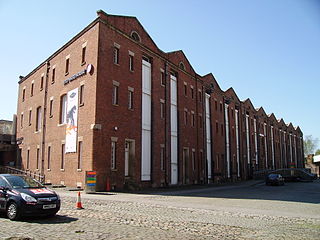
The 1830 warehouse, Liverpool Road, Manchester, England, is a 19th-century warehouse that forms part of the Liverpool Road railway station complex. It was built in five months between April and September 1830, "almost certainly [to the designs of] the Liverpool architect Thomas Haigh". The heritage listing report attributes the work to George Stephenson and his son, Robert. It has been listed Grade I on the National Heritage List for England since May 1973.
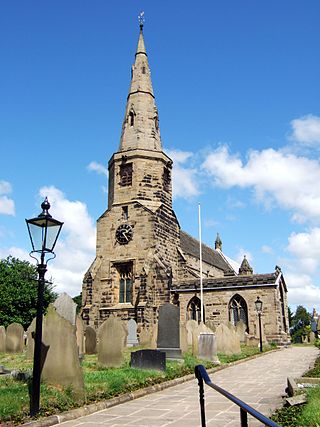
St Cuthbert's Church is an Anglican church in Halsall, a village in Lancashire, England. It is an active parish church in the Diocese of Liverpool and the archdeaconry of Warrington. The oldest parts of the church date from the 14th century and there have been several alterations and additions. It is recorded in the National Heritage List for England as a designated Grade I listed building.
Culshaw and Sumners was a firm of English architects and surveyors who practised in Liverpool in the 19th and early 20th centuries. The work of the practice reflected the growing economic prosperity of the city during this period. Much of its work was routine and mundane, but it did produce some notable buildings, including office blocks, warehouses, domestic properties, workhouses, churches, and a hospital. The firm was established by 1839 by William Culshaw, who was joined by Henry Sumners in 1861. Following Culshaw's death in 1874, the practice was continued until 1916 by his son, Alfred.

Sacred Heart Church is a Grade II listed redundant Roman Catholic church on Tyldesley Road, Hindsford, Atherton in Greater Manchester, England. It has been designated by English Heritage as a Grade II listed building.
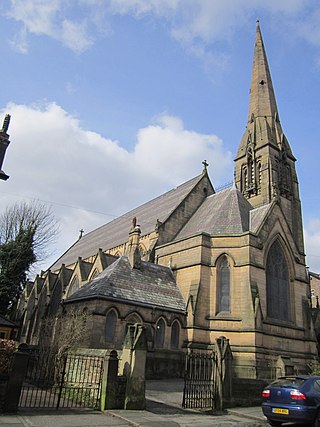
Christ Church, Toxteth Park, is in Linnet Lane, Liverpool, Merseyside, England. It is an active Anglican parish church in the deanery of Wavertree and Toxteth, the archdeaconry of Liverpool, and the diocese of Liverpool. Its benefice is united with that of St Michael, Aigburth. The church is recorded in the National Heritage List for England as a designated Grade II listed building.
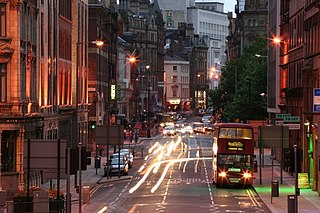
Victoria Street is a road in Liverpool, England. Situated in the city centre, it runs between the Queensway Tunnel entrance to Cook Street.
























